 W
WBasalt is a mafic extrusive igneous rock formed from the rapid cooling of lava rich in magnesium and iron exposed at or very near the surface of a terrestrial planet or a moon. More than 90% of all volcanic rock on Earth is basalt, and the eruption of basalt lava is observed by geologists at about 20 volcanoes per year.
 W
WColumnar jointing is a geological structure where sets of intersecting closely spaced fractures, referred to as joints, result in the formation of a regular array of polygonal prisms, or columns. Columnar jointing occurs in many types of igneous rocks and forms as the rock cools and contracts. Columnar jointing can occur in cooling lava flows and ashflow tuffs (ignimbrites), as well as in some shallow intrusions. Columnar jointing also occurs rarely in sedimentary rocks if they have been heated by nearby hot magma.
 W
WColumnar jointed volcanic rocks exist in many places on Earth. Perhaps the most famous basalt lava flow in the world is the Giant's Causeway in Northern Ireland, in which the vertical joints form polygonal columns and give the impression of having been artificially constructed.
 W
WTrap rock, also known as either trapp or trap, is any dark-colored, fine-grained, non-granitic intrusive or extrusive igneous rock. Types of trap rock include basalt, peridotite, diabase, and gabbro. Trapp (trap) is also used to refer to flood (plateau) basalts, e.g. the Deccan Traps and Siberian Traps. The erosion of trap rock created by the stacking of successive lava flows often created a distinct stairstep landscape from which the term "trap" was derived from the Swedish word "trappa", which means "stairway".
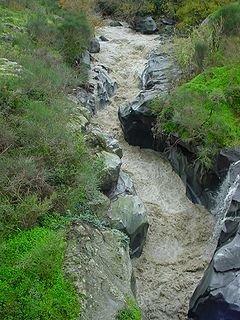 W
WThe Alcantara is a river in Sicily, southern Italy. It has its source on the south side of Monti Nebrodi and its mouth in the Ionian Sea at Capo Schiso in Giardini-Naxos. The river is 52 kilometres (32 mi) long.
 W
WA basalt fan structure is a basalt formation composed of columnar jointed basalt columns that have slumped into a fan shape.
 W
WBasalt Island is an island of Hong Kong and administratively part of the Sai Kung District. Together with Wang Chau and Bluff Island, it forms the Ung Kong Group and is part of Hong Kong Global Geopark.
 W
WBasalt Rocks are volcanic rock outcrops in the form of columnar basalt located in Sinop Province, northern Turkey. The area is a registered natural monument of the country.
 W
WThe Basaltic Prisms of Santa María Regla are tall columnar joints of basalt rock near Huasca de Ocampo in the Mexican state of Hidalgo, that line a ravine through which water runs from the San Antonio Dam. This ravine area was part of the Santa María Regla Hacienda and was first promoted by Alexander von Humboldt in 1803.
 W
WCape Stolbchaty is a geographic cape on the east shore of Kunashir Island of Sakhalin Oblast, Russia. It is famous for its columnar basalt formations, which are strikingly similar to the Giant's Causeway in County Antrim in Northern Ireland.
 W
WMount Cargill, known in Māori as Kapukataumahaka, is a volcanic outcrop which dominates the skyline of northern Dunedin, New Zealand.
 W
WThe Cyclopean Isles, noted for their rows of basaltic columns piled one above another, lie not far from Mount Etna off the eastern coast of Sicily in the Mediterranean Sea.
 W
WThe Daepo Jusangjeolli Cliff cliff is a spectacular volcanic rock formation at the southern coast of Jeju Island, South Korea. It is similar to the Giant's Causeway in Northern Ireland.
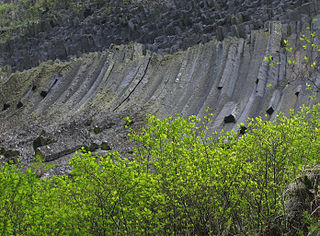 W
WDetunatele is a site of columnar jointing in Transylvania, Alba County, Romania. Detunatele means lightning strike. The columns are hexagonal shaped basalt and 1,258 meters tall on two peaks: Detunata Goala and Detunata Flocoasa. They are located in the Metaliferi Mountains and are a tourist attraction. They are 1.5 km apart. They formations are shaped like humps and there are stories and legends associated with them.
 W
WDevils Postpile National Monument is a National Monument located near Mammoth Mountain in eastern California. The monument protects Devils Postpile, an unusual rock formation of columnar basalt. It encompasses 798 acres (323 ha) and includes two main tourist attractions: the Devils Postpile formation and Rainbow Falls, a waterfall on the Middle Fork of the San Joaquin River. In addition, the John Muir Trail and Pacific Crest Trail merge into one trail as they pass through the monument. Excluding a small developed area containing the monument headquarters, visitor center and a campground, the National Monument lies within the borders of the Ansel Adams Wilderness.
 W
WThe Druidenstein is a cone-shaped basalt rock in the northern Heller Upland above the town of Kirchen on the Sieg in the parish of Herkersdorf, Altenkirchen, Germany. The basalt cone stands at a height 431 m above sea level (NN) and is about 20 metres high.
 W
WFingal's Cave is a sea cave on the uninhabited island of Staffa, in the Inner Hebrides of Scotland, known for its natural acoustics. The National Trust for Scotland owns the cave as part of a national nature reserve. It became known as Fingal's Cave after the eponymous hero of an epic poem by 18th-century Scots poet-historian James Macpherson.
 W
WThe Garni Gorge is situated 23 km east of Yerevan, Armenia, just below the village of the same name. On a promontory above the gorge the first-century AD Temple of Garni may be seen. Along the sides of the gorge are cliff walls of well-preserved basalt columns, carved out by the Goght River. This portion of the Garni Gorge is typically referred to as the "Symphony of the Stones." It is most easily reached via a road that leads left down the gorge just before reaching the temple of Garni. Another road leads to the gorge through the village, down a cobblestone road, and into the valley. Once in the valley, turning right will lead to Garni Gorge, an 11th-century medieval bridge, and the "Symphony of the Stones". Taking a left will lead along the river past a fish hatchery, up to the Khosrov Forest State Reserve, and a little further Havuts Tar Monastery.
 W
WThe Giant's Causeway is an area of about 40,000 interlocking basalt columns, the result of an ancient volcanic fissure eruption. It is located in County Antrim on the north coast of Northern Ireland, about three miles (4.8 km) northeast of the town of Bushmills.
 W
WThe Hexagon Pool is a natural pool in the Meshushim Reserve, part of the Yehudiya Forest Nature Reserve, in the central Golan Heights.
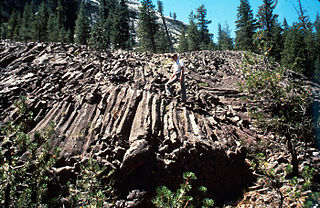 W
WLittle Devils Postpile is a columnar basalt rock formation in the Sierra Nevada, located within Yosemite National Park and eastern Tuolumne County, California.
 W
WMoses Coulee is a canyon in the Waterville plateau region of Douglas County, Washington. Moses Coulee is the second-largest and westernmost canyon of the Channeled Scablands, located about 30 kilometres (19 mi) to the west of the larger Grand Coulee. This water channel is now dry, but during glacial periods, large outburst floods with discharges greater than 600,000 m3/s (21,000,000 cu ft/s) carved the channel. While it's clear that megafloods from Glacial Lake Missoula passed through and contributed to the erosion of Moses Coulee, the origins of the coulee are less clear. Some researchers propose that floods from glacial Lake Missoula formed Moses Coulee, while others suggest that subglacial floods from the Okanogan Lobe incised the canyon. The mouth of Moses Coulee discharges into the Columbia River.
 W
WThe so-called Organ Pipes are situated near the small inselberg of Burnt Mountain, west of the town of Khorixas in Namibia. They are a rock formation that comprises a group of columnar basalts which resemble organ pipes.
 W
WThe Organ Pipes National Park, abbreviated as OPNP, is a national park located in the Central region of Victoria, Australia. The 121-hectare (300-acre) protected area was established with the focus on conservation of the native flora and fauna, and preservation of the geological features in the Jacksons Creek, a part of the Maribyrnong valley, north-west of Melbourne. It is situated in a deep gorge in the grassy, basalt Keilor Plains.
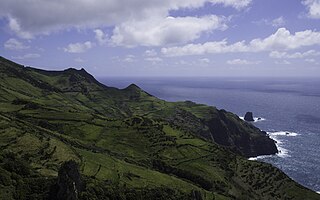 W
WFlores Island is an island of the Western group of the Azores. It has an area of 143 km², a population of approximately 3907 inhabitants, and, together with Corvo Island of the western archipelago, lies within the North American Plate. The nearby Monchique Islet is the westernmost point of Portugal. It has been referred to as the Ilha Amarelo Torrado by marketing and due to the association with poet Raul Brandão, but it is well known for its abundance of flowers, hence its Portuguese name of Flores.
 W
WHolyrood Park is a royal park in central Edinburgh, Scotland about 1 mile to the east of Edinburgh Castle. It is open to the public. It has an array of hills, lochs, glens, ridges, basalt cliffs, and patches of gorse, providing a wild piece of highland landscape within its 650-acre (260 ha) area. The park is associated with the royal palace of Holyroodhouse and was formerly a 12th-century royal hunting estate. The park was created in 1541 when James V had the ground "circulit about Arthurs Sett, Salisborie and Duddingston craggis" enclosed by a stone wall.
 W
WThe Sheepeater Cliffs are a series of exposed cliffs made up of columnar basalt in Yellowstone National Park in the United States. The lava was deposited about 500,000 years ago during one of the periodic basaltic floods in Yellowstone Caldera, and later exposed by the Gardner River. The cliffs are noted as a textbook example of a basaltic flow with well defined joints and hexagonal columns. They were named after a band of Eastern Shoshone known as Tukuaduka. Many of the exposed cliffs are located along a steep inaccessible canyon cut by the Gardner near Bunsen Peak, but some of the cliffs located just off the Grand Loop Road can be reached by car.
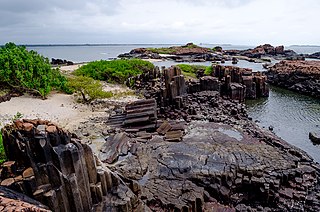 W
WSt. Mary's Islands, also known as Coconut Island and Thonsepar, are a set of four small islands in the Arabian Sea off the coast of Malpe in Udupi, Karnataka, India. They are known for their distinctive geological formation of columnar rhyolitic lava (pictured).
 W
WStaffa is an island of the Inner Hebrides in Argyll and Bute, Scotland. The Vikings gave it this name as its columnar basalt reminded them of their houses, which were built from vertically placed tree-logs.
 W
WThe shape of the so-called “thrown stones” has caught the curiosity of many travelers going to Rome. About a kilometer from the town of Bolsena, which leads to Montefiascone along the Cassia, you can observe a columnar basalt rock formation: naturally-formed prisms of volcanic rock.
 W
WUlva is an island in the Inner Hebrides of Scotland, off the west coast of Mull. It is separated from Mull by a narrow strait, and connected to the neighbouring island of Gometra by a bridge. Much of the island is formed from Cenozoic basalt rocks, which are formed into columns in places.